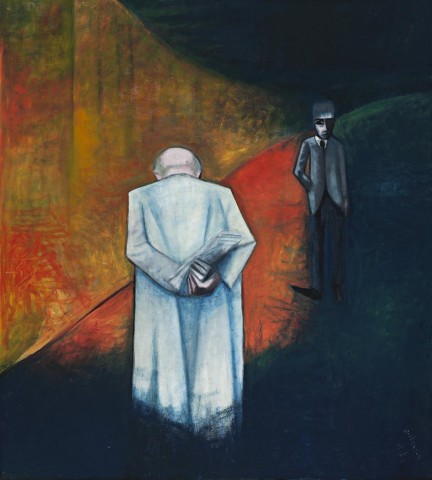TWO MEN IN SUBWAY, 1963
ROBERT DICKERSON
oil on composition board
152.5 x 137.0 cm
signed twice and dated lower right: DICKERSON / 6/8/63 / DICKERSON
dated and inscribed with title verso: ‘TWO MEN IN SUBWAY’ / … / DATE 8/6/63
Private collection
Rushton Fine Arts, Sydney, 17 November 1987, lot 182
Private collection
Sotheby’s, Sydney, 29 November 1993, lot 194
Charles Nodrum Gallery, Melbourne (label attached verso)
Private collection, Melbourne
Robert Dickerson proudly hailed from the school of hard knocks. Raised in conditions of extreme poverty, his natural empathies lay with life’s battlers whose passage through an uncaring urban world he captured in distinctively blunt and angular paintings. His keen eye captured the slightest gesture or attitude between people, moments which served as the basis for images that spoke of wider concerns. Through the simple glance portrayed in Two Men in Subway, 1963, a whole language is established, one which speaks volumes about society’s attitudes and beliefs towards the down-and-out.
The son of a tinsmith, Dickerson left school at 14 having already suffered through three bouts of pneumonia. He took up boxing for his health – a paradox if ever there was one – turning professional at 16, and toured country towns until he was able to sign up at the age of 18. He joined the RAAF and was sent to New Guinea and Indonesia. Once de-mobbed, he found himself stranded for a time on the island of Morotai, and at the urging of friends, started drawing the local children ‘in anything available – charcoal, plywood, whitewash, boot polish’.1 On his return to Australia, Dickerson undertook gruelling factory jobs but such was his commitment to his art that ‘(s)ome of my best early paintings were done in a caravan or shed, and finished in the small hours of the morning, before I left for work’.2 In 1952, Barrett Reid, an associate of the Melbourne Heide circle, met Dickerson in Sydney and enthused by his work, encouraged the artist to visit him in Melbourne, which he did the following year. John and Sunday Reed were also excited by his paintings and invited him to mount a solo exhibition at their newly formed Gallery of Contemporary Art in Melbourne in 1956. By the end of the decade, his paintings were in the collections of the National Gallery of Victoria, Ballarat Fine Art Gallery, and the Art Gallery of New South Wales. Not bad for a self-trained artist.
Two Men in Subway was painted soon after his short-lived association with ‘The Antipodean’ group of artists and whilst his paintings from the earlier 1950s were somewhat muted (soft greys, caramels and yellows), the works from 1959 onwards are marked by a richer intensity of colour and feature large expanses of agitated brushwork. Here, the orange and green subterranean wall sweeps in from the left to enclose the two figures, with the upper line aligning to the hostile stare the businessman is casting back at the humbled old man, newspaper clutched behind his back, shoulders slumped in submission. Such encounters are sadly common but only Dickerson was moved enough to capture and paint this casual encounter on such a large scale, a form of protest at people’s self-centered disdain, emphasised further by the caustic application of his signature at the lower right, like an angry graffiti scrawl. Two Men in Subway is a vivid testimony to the often harsh realities of contemporary urban life painted by an artist who never forgot that his own heritage was embedded in similar impoverished conditions.
1. Ivanyi, A., Robert Dickerson: survey 1947-1992, exhibition catalogue, Caulfield Arts Complex, Victoria, 1993, unpaginated
2. ibid.
ANDREW GAYNOR
